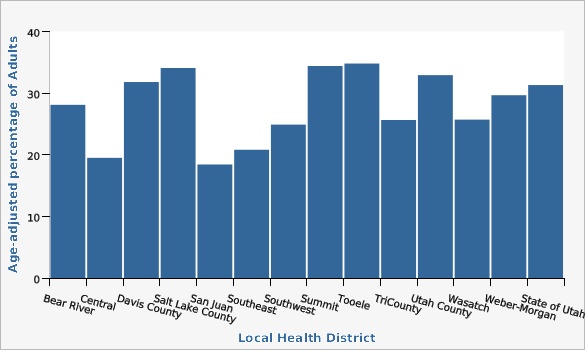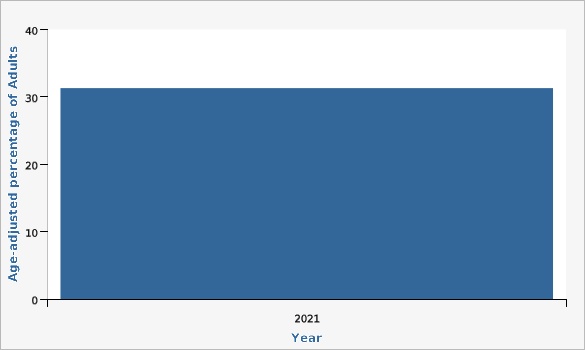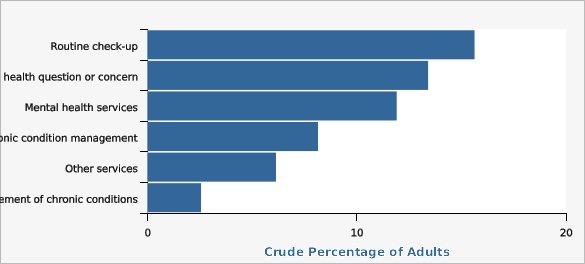Complete Health Indicator Report of Telehealth utilization
Definition
Percentage of Utah adults (18+) utilizing telehealthNumerator
Number of Utah adults reporting telehealth servicesDenominator
Total number of Utah adultsData Interpretation Issues
The BRFSS is a telephone survey (with interviews using both landline and cell phones) that includes only adults 18 and over.Why Is This Important?
Telehealth (also known as telemedicine) lets healthcare providers provide care without an in-person office visit. In-person office visits with a healthcare provider may be necessary in certain cases, however, there are many benefits to telehealth: * Limited physical contact reduces everyone's exposure to COVID-19 * Virtual visits ensure you get health care wherever you are located - at home, at work, or even in your car *Virtual visits cut down on travel, time off from work, and the need for childcare * Virtual healthcare tools can shorten the wait for an appointment * Increased access to specialists who are located far away from your hometownOther Objectives
Healthy People 2030 (HP 2030) has created a research objective tied to telehealth, [https://health.gov/healthypeople/objectives-and-data/browse-objectives/health-it/increase-use-telehealth-improve-access-health-services-ahs-r02 HP 2030 Objective AHS-R02 "Increase the use of telehealth to improve access to health services"]How Are We Doing?
The first case of COVID-19 in Utah was in March 2020. In April 2020, 43.9% of medical claims from the All Payers Claim Database (APCD) were for telehealth visits. While telehealth visits have decreased since then, they have remained around 12-13% since July 2021.Evidence-based Practices
[https://www.cochranelibrary.com/cdsr/doi/10.1002/14651858.CD007718.pub2/full Telehealthcare for chronic obstructive pulmonary disease]Available Services
[https://nrtrc.org/ Northwest Regional Telehealth Resource Center] [https://telehealth.hhs.gov/ Tips for Telehealth Success for Patients and Providers]Health Program Information
The Utah Department of Health and Human Services, Healthy Environments Active Living program plays a key role in improving the health of residents in the state of Utah. The program was formed in July 2013 (as EPICC), through a new funding opportunity from the Centers of Disease Control and Prevention (CDC) that allowed for the merging of three previously existing programs: the Heart Disease and Stroke Prevention Program, the Diabetes Prevention and Control Program, and the Physical Activity, Nutrition and Obesity Program, as well as the addition of a school health program. The Healthy Environments Active Living Program (HEAL) was recently restructured as part of this strategic planning process and the new program model focuses on working together with staff and partners to address the social determinants of health while advancing health equity and increasing policy, systems and environment changes. HEAL champions public health initiatives and addresses the challenges of making health awareness and access truly universal and equitable in eight key areas: nutrition, heart health, diabetes, physical activity, schools, child care, community health workers, and worksites. Visit [https://heal.utah.gov/ HEAL's website] for more information.Related Indicators
Related Relevant Population Characteristics Indicators:
Related Health Care System Factors Indicators:
- Managed Care (CAHPS) Survey: Patient Rating of Experience with Getting Needed Care
- Managed Care (CAHPS) Survey: Patient Rating of Health Care Experience
- Cost as a barrier to health care
- No health insurance coverage
- Uninsured Children
- Physician Supply
- Personal doctor or health care provider
- Routine medical care visits
Graphical Data Views
| Year | Age-adjusted percentage of Adults | Lower Limit | Upper Limit | |||
|---|---|---|---|---|---|---|
Record Count: 1 | ||||||
| 2021 | 31.3% | 30.1% | 32.6% | |||
Data Notes
"Don't know" and "Refused" responses were eliminated from the denominator. In 2016, Utah BRFSS modified its methodology for age adjustment for increased precision. With this change Utah is consistent with both the U.S. and other states using IBIS. Data has been updated from 2011 onward in all chart views to reflect this change.Data Sources
- Utah Department of Health and Human Services Behavioral Risk Factor Surveillance System (BRFSS)
- Population Estimates: National Center for Health Statistics (NCHS) through a collaborative agreement with the U.S. Census Bureau, IBIS Version 2020
Telehealth utilization among adults by Local health district 2021

Central, San Juan County, Southeast, and Southwest Local Health Districts had a lower rate than the state. The overall age-adjusted rate for the state was 31.3%.
| Local Health District | Age-adjusted percentage of Adults | Lower Limit | Upper Limit | |||
|---|---|---|---|---|---|---|
Record Count: 14 | ||||||
| Bear River | 28.1% | 23.7% | 32.9% | |||
| Central | 19.5% | 15.4% | 24.4% | |||
| Davis County | 31.8% | 28.0% | 35.9% | |||
| Salt Lake County | 34.1% | 31.9% | 36.4% | |||
| San Juan | 18.4% | 12.0% | 27.2% | |||
| Southeast | 20.8% | 14.6% | 28.8% | |||
| Southwest | 24.9% | 20.4% | 30.1% | |||
| Summit | 34.4% | 24.7% | 45.6% | |||
| Tooele | 34.8% | 28.6% | 41.5% | |||
| TriCounty | 25.6% | 20.9% | 31.1% | |||
| Utah County | 32.9% | 30.4% | 35.6% | |||
| Wasatch | 25.7% | 18.0% | 35.3% | |||
| Weber-Morgan | 29.7% | 25.4% | 34.3% | |||
| State of Utah | 31.3% | 30.1% | 32.6% | |||
Data Notes
"Don't know" and "Refused" responses were eliminated from the denominator. In 2016, Utah BRFSS modified its methodology for age adjustment for increased precision. With this change Utah is consistent with both the U.S. and other states using IBIS. Data has been updated from 2011 onward in all chart views to reflect this change.Data Sources
- Utah Department of Health and Human Services Behavioral Risk Factor Surveillance System (BRFSS)
- Population Estimates: National Center for Health Statistics (NCHS) through a collaborative agreement with the U.S. Census Bureau, IBIS Version 2020
The most common reason Utahns utilized telehealth was for routine check-ups (15.6%).
| Crude Percentage of Adults | Lower Limit | Upper Limit | ||||
|---|---|---|---|---|---|---|
Record Count: 6 | ||||||
| Routine check-up | 15.6% | 14.6% | 16.7% | |||
| Urgent or acute health question or concern | 13.4% | 12.4% | 14.4% | |||
| Mental health services | 11.9% | 10.9% | 13.0% | |||
| Chronic condition management | 8.2% | 7.4% | 9.0% | |||
| Other services | 6.1% | 5.4% | 6.9% | |||
| Group classes for prevention or self-management of chronic conditions | 2.6% | 2.1% | 3.1% | |||
Data Notes
"Don't know" and "Refused" responses were eliminated from the denominator. In 2016, Utah BRFSS modified its methodology for age adjustment for increased precision. With this change Utah is consistent with both the U.S. and other states using IBIS. Data has been updated from 2011 onward in all chart views to reflect this change.Data Source
Utah Department of Health and Human Services Behavioral Risk Factor Surveillance System (BRFSS)References and Community Resources
[https://utn.org/ Utah Education and Telehealth Network] [https://nrtrc.org/ Northwest Regional Telehealth Resource Center] [https://www.cochranelibrary.com/cdsr/doi/10.1002/14651858.CD007718.pub2/full Telehealthcare for chronic obstructive pulmonary disease] [https://telehealth.hhs.gov/ Tips for Telehealth Success for Patients and Providers]More Resources and Links
Evidence-based community health improvement ideas and interventions may be found at the following sites:- Centers for Disease Control and Prevention (CDC) WONDER Database, a system for disseminating public health data and information.
- United States Census Bureau data dashboard.
- Utah healthy Places Index, evidence-based and peer-reviewed tool, supports efforts to prioritize equitable community investments, develop critical programs and policies across the state, and much more.
- County Health Rankings
- Kaiser Family Foundation's StateHealthFacts.org
- Medical literature can be queried at PubMed library.
Page Content Updated On 05/03/2023,
Published on 05/03/2023


